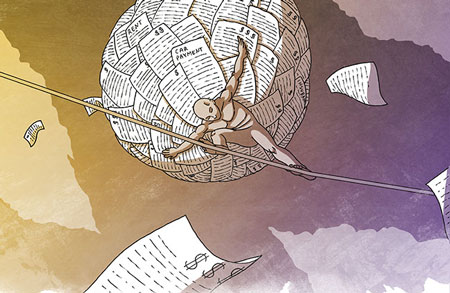The beast of burden
Half of Clark students receive financial aid
Far fewer get scholarships
By Rhonda Morin
It costs about $4,000 for tuition and some fees to attend Clark College for a year. Tack on another $1,000 for books, supplies, other fees and thousands more for living expenses such as rent, food and transportation. All told, the Financial Aid Department estimates it costs $18,000 for a Washington resident living on their own to attend Clark full time for nine months. Those students living with parents and attending full time pay $11,000.
Most programs are 18 months, some longer, and some cost more, such as nursing, dental hygiene and medical radiography.
To help students pay for college, Clark’s Financial Aid office generates $50 million in aid packages per year, according to Karen Driscoll, director of Financial Aid. Those portfolios consisted of federal Pell Grants at nearly $20 million and State Need Grants totaling $7 million in 2013-2014. Institutional grants, state and federal work study, welfare-to-work initiatives and other sources, make up the rest.
Last year, half of Clark’s students received some form of financial aid. However, 8,225 students out of 16,566 received no federal or state aid, according to Clark’s Planning and Effectiveness office. Scholarships, either administered by the college or from private giving through Clark College Foundation, were distributed to about 1,190 students.
The average annual student loan debt for current Clark students was $5,143 in 2013-2014. The state does not provide cumulative debt totals for community college graduates. However, what is known is that 3,500 Clark students owed $24 million in 2012-2013 for subsidized and unsubsidized loans, according to Driscoll.
In comparison, other Washington’s community and technical college students had an average annual loan debt of $5,600 in 2012-2013, according to a Washington Student Achievement Council report from December 2013.
Officials claim that the average annual debt students accumulate is lower at Clark than the state’s average because of the variety of financial resources available.
“We’re funding students with other sources, like Pell and other types of grants,” said Driscoll.
Scholarship relief for some
Scholarships are another way to avoid debt. More than $1.8 million was awarded to students last year at Clark. However, that’s a small fraction of the student population and the need.
Clark College Foundation distributed more than $620,000 in scholarships last year. The foundation expects to provide $750,000 this year. The awards vary from full to partial tuition. The scholarships may also cover books and fees in come cases.
“Scholarships are a lifesaver,” said Lisa Gibert, president/CEO of Clark College Foundation. “They can be the difference between attending and not attending Clark for many students. And they are made possible from donors who believe in the power of education.”
State and community scholarships, which are administered by Clark’s Financial Aid office, totaled nearly $1.2 million in 2013-2014, according to Driscoll.
Nationally, Clark College Foundation ranks higher in the amount of dollars awarded than its counterparts. The national mean was $361,000 last year with an average scholarship amount of $1,126. Clark College Foundation’s awarding of $620,000 equaled an average of $1,300 per student, according Gibert.
| More than 8,200 Clark students received no federal or state aid last year. |
| Each year, Clark students accumulate an average debt of $5,100. |
Repaying loans
For those who do not receive scholarships or grants, the burden of debt weights heavily on their minds, adversely affecting their spending habits and the economy.
Overall, student loan debt across the nation has ballooned, touching off a windstorm of debate. The Vanguard Group reported in August 2014 that student loan debt has doubled since the recession started in 2007 and is affecting the probability of students owning a home by 1.5 percent. However, student loan debt is not like the mortgage crisis, and will not lead to a pervasive economic problem, according to U.S. News & World Report.
In the state of Washington, the per capita student debt has risen nearly 120 percent since 2004, according to Scott Bailey, regional economist with the Washington Employment Security Department. It has more than doubled, from $1,615 to $3,540, over 11 years. Meanwhile, incomes that are used to repay those loans are stagnant.
“Median household incomes in Clark County declined with the recession and have not recovered. Average wages for younger workers, aged 25 to 34, declined by about 5 percent over the past decade in Clark County,” Bailey said.
On the bright side, job growth was up nearly 5 percent in early 2015. Jobs were mostly added to upper-level management and professional jobs, Bailey said. He predicts a positive year in terms of job growth.
Have a plan
Though a recovering economy may help Clark graduates find jobs, the Financial Aid office continues to educate students on the importance of having a plan for repaying their loans. Every quarter, Debbie Maurina, Clark’s financial aid spectakes multiple steps to keep students informed on the amount they borrow and what they will owe once they leave, all the time encouraging them to complete their degree.
“Seek first to understand what’s going on,” she said, adding, “I know life happens, so I ask students ‘how can I help?’ I can refer them to others for guidance, like math tutors and state and federal financial resources.”
Throughout their college experience, Maurina sends emails reminding borrowers to check their outstanding loan balances, loan status and other information on the National Student Loan Data System. She also calls them into her office to chat about how they’re doing in their courses or provide money-management resources like SALT, an online source for financial solutions geared toward students and alumni.
Before graduation day, the financial aid office sends students a congratulatory message coupled with directions for reviewing how much they borrowed, their repayment plan, default consequences and other information on the federal student aid website.
However, these approaches require students to open the emails and plug in information to generate repayment numbers. After several attempts were made by a reporter to encourage Clark student Stephen Miller, who is studying web development (see sidebar), to visit a federal student aid website and generate his monthly repayment amount, he received an incomplete chart.
“I’m confused by the process,” he said in an email.
| Washington State’s per capita student debt has more than doubled in 10 years. |
| Nearly $2 million in scholarships were distributed last year at Clark. |
Affecting future
The effects of increased student debt are being felt across Clark County, Southwest Washington and beyond.
“We’re seeing lower car ownership among millennials,” economist Scott Bailey said. “If people run into problems paying back their loans, it reflects on their credit records and makes it harder to buy cars and homes and even to get a rental unit. Also, unlike other debt, student debt does not go away in bankruptcy proceedings.”
Some officials believe that student debt effects the economy and taking steps to ease the burden may inject prosperity into regions of the state struggling with sluggish growth. Scholarships are one way to lessen the burden. Clark’s high-dollar awards are thanks to a history of community support—individuals and organizations who understand the power that education has on society.




